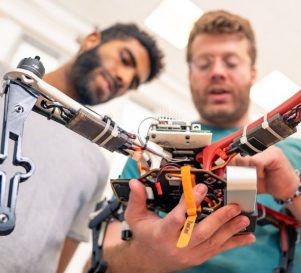Aeroelastic flutter is a destructive instability phenomenon for which dedicated flight test campaigns are considered compulsory according to airworthiness regulations.
As the use of autonomous robotic vehicles is increasing in everyday applications, issues regarding the performance of these vehicles become
A stationary Leading-Edge-Vortex (LEV) formed over the upper wing surface is one of the primary mechanisms to achieve high lift
Over the past twenty years, the field of Computational Fluid Dynamics (CFD) has been evolving drastically, following the progress of
A summary of the lunar environment is provided as background to the issues that await resolution by structural engineers who
Two main research projects that are developed at the Applied Research Laboratory in Active Controls, Avionics and AeroServoElasticity LARCASE are
Satellite navigation constellations orbit the Earth in medium and geosynchronous orbits. These high altitudes raise the operational and launching costs,
Recent progress in experimental biomechanics has provided reliable hyperelastic constitutive parameters for a variety of soft biological tissues like brain,
The thrust of a solid rocket motor (SRM) mainly depends on the combustion chamber pressure, nozzle geometry and propellant characteristics.
This work presents a new approach for solving the coverage problem for large areas given a limited number of sensors. We
Understanding flow instability mechanisms in boundary layers is valuable for designing more efficient aerodynamic and hydrodynamic surfaces. This talk consists
Buckling of a slender elastic column under static compressive load is a fundamental and classical problem in structural stability. It
Air-breathing engines as ramjets, scramjets, turbojets, and turbofans have higher specific impulse and energetic performance and, hence, longer range for
The current research is focused around the development of a variable cycle micro-turbofan engine an existing micro-turbojet with less than
The general trend in missile development is towards longer, faster, high-maneuverability missiles. This makes missiles increasingly more flexible and therefore
The problem of finding optimal trajectories is a basic problem in aerospace engineering with many different solution algorithms. One widely
Aft-sting mount is the most common method of mounting wind tunnel models when performing aerodynamic (balance) measurements in wind tunnels,
At linear flutter onset conditions, an aircraft undergoes self-excited harmonic oscillations in response to any initial trigger, leading to a
Blunt nose shapes such as flat-face, hemisphere and ellipse are of supreme interest among the bodies moving at supersonic speeds
In the past decade growing numbers of nanosatellites are being used in space, with an-ever increasing mission demands. Nevertheless, due
Boron based gelled fuels are promising candidates for certain future ramjet applications, offering potential improvements in performance and/or safety over
The tools necessary for the aeroelastic design of very flexible aircraft with geometric nonlinearities are limited. The present work describes
With the onset of autonomous spacecraft formation flying missions, the ability of satellites to autonomously navigate relatively to other space
In 1809, almost a century before the first human flight, the polymath Thomas Young opened his lecture “On the functions
Over the years, different methods have been developed in order to obtain suitable sprays for different applications. The most important
Long-term satellite formation keeping must account for the effects of orbital perturbations. While long-term formation keeping around the Earth has
We study dipolophoretic (DIP), i.e. the combined induced – charge electrophoretic (ICEP) and dielectrophoretic (DEP) interactions between a pair of









